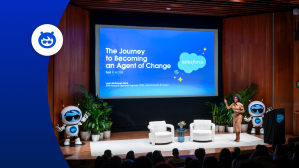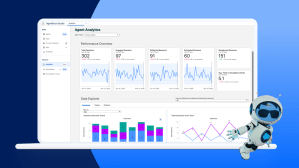Key Takeaways
- Successful organizations in the age of agentic AI will distinguish between tasks entrusted to AI for predictable, routine processes (the “autonomic core”) and those requiring human judgment for strategic decisions.
- The autonomic core, powered by agentic AI, handles variance and optimizes for outcomes at scale, dynamically adjusting to business rhythms and escalating unusual situations to human-plus-AI teams for critical problem-solving.
Editor’s Note: This is the first in a new series from the Salesforce Futures team exploring the future of the Agentic Enterprise.
Many executives harbor a seductive vision of AI automation: a sleek, ultra-lean organization that runs with minimal human oversight. The promise of lower costs, faster operations, and round-the-clock productivity makes it an alluring prospect.
Who wouldn’t want (at least in theory) a business that hums along on its own while leadership focuses on the big picture?
Yet that’s unlikely to be how successful organizations will work in the age of agentic AI. The companies that thrive won’t succeed by automating everything. They’ll win by distinguishing between tasks that should be entrusted to AI and those that require human judgment.
Consider how your body handles this balance. Your heart doesn’t need a memo to beat 100,000 times a day. Your digestive system processes nutrients without performance reviews. Your lungs keep you breathing even when you’re asleep. These systems are “autonomic”: involuntary, automatic, and self-regulating. Most of the time they run quietly in the background — until something unusual calls attention to them. In business terms, the same is true: Predictable, routine processes can run on autopilot, only rising to leadership’s attention when they stray outside the norm.
Meanwhile, you weigh every word in a high-stakes client conversation and carefully consider whether to buy capabilities through acquisition or build them in-house — even as you increasingly lean on AI to help guide your thinking. Humans augmented by AI tools — not an AI agent acting alone — make these strategic decisions.
This division between the automatic and the intentional isn’t just elegant biology — it’s a useful way to think about AI in business.
Marc Escobosa, VP, Salesforce Futures
This division between the automatic and the intentional isn’t just elegant biology — it’s a useful way to think about AI in business. Call it your “autonomic core”: the set of functions that run quietly in the background so people can focus attention where it matters most.
Why agentic AI changes everything
We’re entering the era of agentic AI — systems that can act independently to complete complex tasks. What sets these agents apart is their ability to handle variance.
They can process requests in many languages, decipher prompts riddled with spelling errors, recognize intents phrased six different ways, and adapt midstream when circumstances change, showing a resilience that earlier systems lacked.
Before generative AI, automation was brittle. Rules-based systems demanded coding skills, which turned IT into an operational bottleneck. Every exception — every edge case — meant another trouble ticket in the backlog that required a developer to fix while customers dealt with the consequences of our incomplete imaginations.
Once set up, agentic AI doesn’t require coding skills. It doesn’t care about departmental silos. Give it a goal — to maximize customer lifetime value, for instance — and it will optimize for that outcome without getting bogged down in whether each incremental dollar should come from sales or marketing. The agent doesn’t have an ego or play office politics. It doesn’t let ambition cloud its judgment.
What belongs in your autonomic core
Of course, not every business function can — or should — be fully autonomous, and every company will have its own appetite for how much to make autonomic. Payroll, onboarding flows, routine data processing, and data pipelines can be heavily automated. Standard customer service can mostly handle itself. Agentic AI shines when processing massive quantities of data, optimizing for outcomes, and coordinating across functions and departments to handle routine tasks at scale.
Agentic AI shines when processing massive quantities of data, optimizing for outcomes, and coordinating across functions and departments to handle routine tasks at scale.
Marc Escobosa, VP, Salesforce Futures
But VIP service requires human judgment. Strategic decisions about new markets demand conscious intention. High-stakes creative choices still depend on human taste and values.
The key is that humans aided by AI excel at different things than agents working alone. Humans with agents are better at navigating ambiguity, expressing values, integrating cross-domain knowledge, and taking responsibility when things go wrong.
One key nuance to keep in mind: Just as your breathing adjusts based on your environment and behavior, speeding up when you run and slowing down when you sleep, an effective autonomic core should work the same way by dynamically adjusting to the rhythm of your business. In anticipation of Black Friday, it scales to handle surges. When market conditions shift, it adapts within expected ranges, escalating only if necessary.
In other words, this isn’t mindless automation — it’s intelligent automation that knows when to escalate. Your autonomic core operates in the background until it recognizes something unusual: “I’ve noticed a sudden change in price elasticity for this product among under-30 buyers who shop primarily on a mobile app.” At that point, it escalates to what we call the human-plus-AI layer — cross-functional teams of smart problem solvers who can diagnose and respond, which could have profound implications for the shape of future workforces.
Success will mean setting clear thresholds: defining normal variance versus genuine exceptions.
Marc Escobosa, VP, Salesforce Futures
Set thresholds like a physician tracks vitals
Think of this like physicians monitoring vital signs. Doctors don’t want an alert every time someone’s heart rate increases by two beats per minute or if their blood pressure remains within the acceptable range. Instead, they watch for meaningful patterns based on historical data — and use blood pressure cuffs, blood tests, and other diagnostic tools to catch problems early.
Your business should do the same. You don’t want alerts if there’s a small backlog in a warehouse that clears itself by morning. But you do want early warning when trends hint at something serious, like a supplier consistently missing shipments.
Success will mean setting clear thresholds: defining normal variance versus genuine exceptions. Done well, you build an early warning system that delivers the right information at the right time with enough lead time to head off trouble.
The competitive advantage
Here’s the counterintuitive truth: The companies that will win won’t be those with the most automation. They’ll be the ones with the best learning loops coming out of their autonomic core.
That means three things: building robust cores that handle routine processes with minimal oversight, getting the balance right between what stays in the background and what gets surfaced, and creating learning loops so every escalation strengthens the system.
The real value comes at the edges — when judgment, creativity, and cross-domain thinking are needed most. The question isn’t “How much can we automate?” but “What deserves our conscious attention?” Push as much as possible into the core so your people can focus on the work only humans — working with AI — can do well. Companies that strike this balance won’t just pull ahead today; they’ll be positioned to sustain an advantage for years to come.
More information:
- Read more insights from the Salesforce Futures team
- Find out why imagination should shape the future of work
- Read more on how Agentforce is inventing the future of agents
- Learn more about personal AI agents
- Peek into the future of AI-human collaboration at work



















